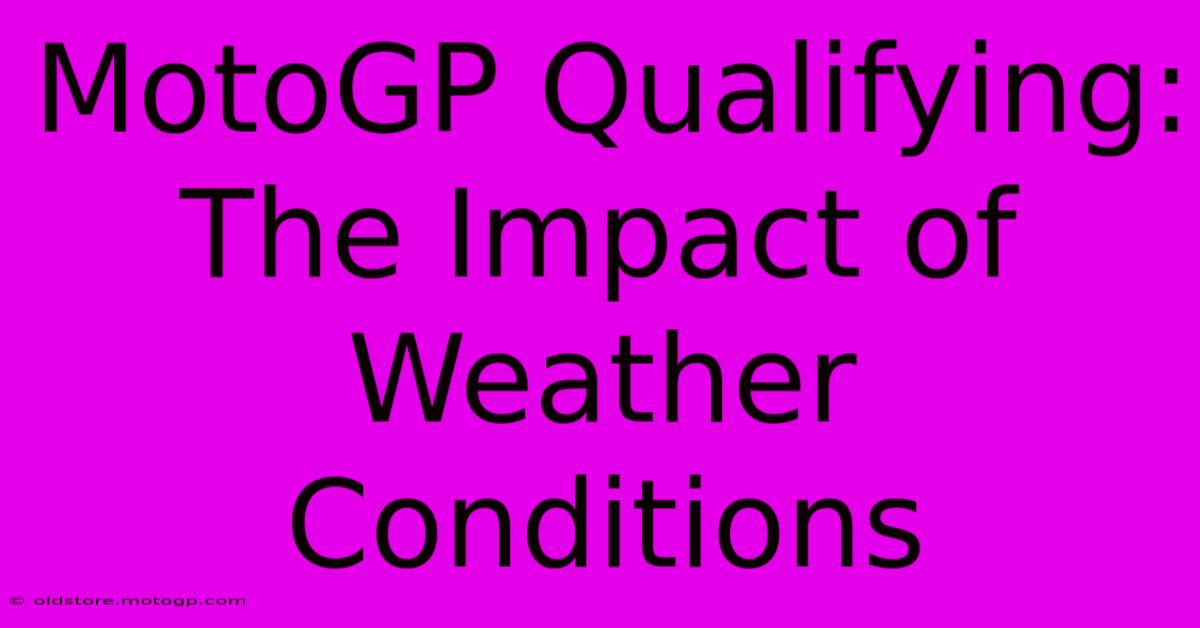MotoGP Qualifying: The Impact Of Weather Conditions

Table of Contents
MotoGP Qualifying: The Impact of Weather Conditions
MotoGP qualifying is a high-stakes battle for pole position, a crucial advantage for race day. But the unpredictable nature of weather can dramatically alter the dynamics of the session, turning strategies upside down and rewarding adaptability and bravery. Understanding how different weather conditions affect qualifying is key to appreciating the skill and nuance involved in this pivotal moment of a Grand Prix weekend.
The Sun's Embrace: Dry Qualifying and its Challenges
A dry qualifying session, while seemingly straightforward, presents its own complexities. Track temperature plays a vital role; a scorching track can lead to rapid tire degradation, forcing riders to manage their pace carefully. Finding the perfect balance between pushing for a fast lap and preserving tires for the race is a delicate act. Even the slightest mistake can prove costly, especially with the tight margins separating top riders.
Key Factors in Dry Conditions:
- Tire Choice: Selecting the appropriate tire compound for the track temperature and grip levels is paramount. Harder compounds offer more longevity but sacrifice grip, while softer compounds provide superior grip but wear out quicker.
- Track Evolution: The track surface evolves throughout the session as rubber is laid down. Riders need to adapt their riding style and lines as grip improves.
- Slipstreaming: Utilizing the slipstream of other riders to gain an aerodynamic advantage is crucial, demanding precise timing and positioning.
- Wind Conditions: Unexpected gusts of wind can disrupt a rider's line and destabilize the bike, adding another layer of challenge.
The Rain's Reign: Wet Qualifying – A Different Beast
Wet qualifying introduces a whole new set of variables. Visibility is significantly reduced, grip is dramatically lowered, and the risk of crashes is exponentially increased. Riders must adapt their riding style, choosing appropriate wet-weather tires and adjusting their braking and cornering techniques. The choice of slicks versus wets also plays a critical role, and making the right call at the right time is crucial.
Navigating the Challenges of Wet Qualifying:
- Tire Selection: The choice between full wets, intermediate wets, and even slicks (in the case of drying tracks) is critical and hinges on track conditions.
- Water Spray: Managing water spray kicked up by other riders can severely impair visibility, demanding extra focus and caution.
- Aquaplaning: The risk of aquaplaning, where the tires lose contact with the track surface, is ever-present, requiring delicate throttle control.
- Track Temperature Fluctuations: Even in wet conditions, track temperature variations can influence tire performance.
The Chameleon Qualifying: Mixed Conditions and the Ultimate Test
The most challenging scenario is a mixed-conditions qualifying session, where parts of the track are dry and others are wet. This requires exceptional skill and judgment, as riders must navigate varying grip levels within the same lap. Adaptability is key; riders need to adjust their lines and riding style dynamically depending on the track segment. Choosing the correct tires adds another level of complexity.
The Art of Mixed Conditions:
- Rapid Adaptation: The ability to seamlessly transition between dry and wet riding styles is paramount.
- Tire Management: Deciding which tires to use – and when – is a complex strategic decision.
- Risk Assessment: Taking calculated risks is essential to secure a strong starting position while mitigating the chances of a crash.
The Impact on Race Day
The outcome of qualifying directly impacts race strategy. A front-row start provides a significant advantage, enabling riders to control the pace and avoid some of the chaos of the opening laps. However, weather conditions can nullify this advantage. A rain-soaked race can quickly shuffle the order, making qualifying performance less of a decisive factor.
In conclusion, MotoGP qualifying is far more than a simple time trial; it's a high-pressure test of skill, judgment, and adaptability, heavily influenced by the vagaries of weather. Mastering the nuances of different conditions is the key to success, and the most skilled riders are often those who can best adapt to the unpredictable nature of the weather.

Thank you for visiting our website wich cover about MotoGP Qualifying: The Impact Of Weather Conditions. We hope the information provided has been useful to you. Feel free to contact us if you have any questions or need further assistance. See you next time and dont miss to bookmark.
Featured Posts
-
Moto Gp Watch Expert Commentary And Analysis
Feb 25, 2025
-
The Ultimate Vip Experience Club Si Austin F1
Feb 25, 2025
-
Boost Your F1 Knowledge Understanding Driver Ratings
Feb 25, 2025
-
Track Ready Beasts Motorcycle Race Bikes For Sale
Feb 25, 2025
-
Lot R Cota Dont Miss Out
Feb 25, 2025
